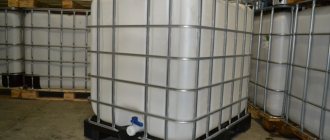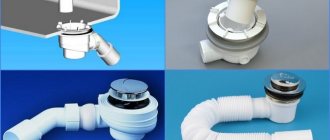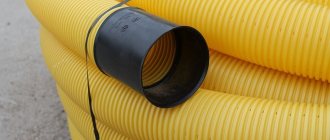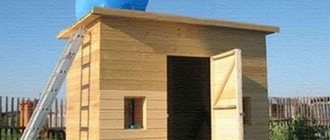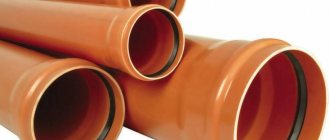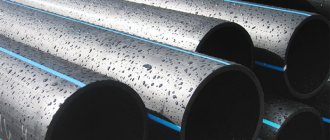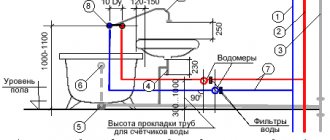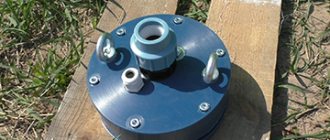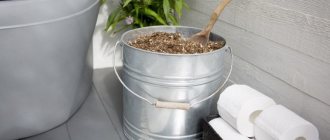Drainage pipes: what they are and how they work
They are also called drains. They perform the functions of receiving and discharging water, which are so necessary and important for draining the area. A system of interconnected drains is called drainage.
The principle of their operation is simple and clear, so land owners most often make the drainage system on their own. Drains are laid along or around the site (building) with a slope of 1% (1 cm per meter) towards any drainage basin (ditch, collector well, pit, canal, reservoir) or the lowest point of the area. Gravel, sand and soil are poured on top.
Drains can be drainage (suction) and collecting. On the walls of the drainage pipes there are holes located in a certain order. It is through the walls and connection points that water enters the drains and is transferred to collectors (drainage wells), and from there through collecting cavities it is discharged beyond the boundaries of the drained area. In this way, a sufficiently thick, dry, stable piece of land is formed.
Left: perforated drainage pipe. Right: collection drainage pipe (discharging water outside the site) without perforation
Laying technology
For the system to work properly, you need to know how to properly lay the drainage pipe, depending on the type. For each drainage pipe, the installation technology will vary slightly depending on the design. But the initial stage is the same for everyone:
- Develop a drainage scheme: location of pipes, places for wells and revisions.
- Depending on the type of soil, the geological characteristics of the site, the location of groundwater and the required throughput, the size and type of drainage pipe are selected.
- Based on the planned route for wiring drainage pipes on the site, site planning and markings are carried out for excavation work.
The ideal option is when the drainage scheme is developed together with the house design Source mainstro.ru
- They dig trenches. On dense soils with straight walls, on loose soils - with sloped walls, or strengthen them during work. The bottom is made 30 cm wider on both sides of the pipe.
- Level the bottom surface, compact the soil, form a slope towards the drainage well within 0.5-3.0% (minimum 0.5 cm and maximum 3 cm for each meter of length).
- Pour a layer of coarse sand about 15 cm thick and compact it, observing the slope laid down during the formation of the ditch bottom.
Further technology for laying the drainage pipe depends on its design.
Laying a drainage pipe with geotextile, if it does not have a factory winding:
- Geotextiles are laid on top of the sand. The width of the canvas should be sufficient so that the edges can then be brought together.
- Pour a layer of crushed stone (15 cm).
- Lay a perforated pipe and cover it with a layer of crushed stone on top.
- The edges of the geotextile fabric are wrapped and fastened together. As a result, the pipe should be uniformly filled with crushed stone on all sides of about 15 cm, the textiles should run along the sand-crushed stone boundary, and there should be free space left to the walls of the trench.
The principle of drainage is that water seeps through geotextiles, crushed stone and perforation, then flows by gravity through a pipe to the well. Source pogreb-podval.ru
Types of drainage pipes
In the modern world, with the advent of new technologies, the requirements for drainage systems are constantly growing. The use of outdated schemes and materials is impractical and difficult.
Asbestos-cement pipes, as well as ceramic ones, are already a thing of the past. They have been replaced by plastic drainage materials - lightweight, comfortable, flexible, non-corrosive, reliable, safe and durable. They can withstand high temperature fluctuations (-70 to +50°C) and are easy to install, so you can easily install them yourself. For their manufacture use:
- Viniplast or UPVC (unplasticized polyvinyl chloride);
- polyethylene HDPE and PVC (low and high density).
Corrugated HDPE drainage pipe has higher strength. It can be buried to a greater depth than smooth-walled
Where are drainage pipes used?
Drainage pipes have found application not only in everyday life for draining excess groundwater from foundations and plinths and constructing drainage wells, but also in civil and industrial construction (land reclamation, laying highways). For each case, it is necessary to correctly select the dimensions and manufacturing technology of the elements.
Dimensions
When choosing drainage pipes, it is important to correctly determine their size. The performance of the entire system depends on the diameter of the drains. For domestic needs, materials Ø 200 mm will be sufficient, and to drain a large volume of water, pipes Ø 300–400 mm will be needed. The most common are elements with a diameter of 110 mm.
To accurately determine the size, you need to consider:
- soil texture;
- level of soil freezing and moisture;
- planned volumes of drainage;
- pipe laying depth (for each diameter there is a maximum permissible depth);
- trench width. It should be 40 cm larger than the diameter of the pipe.
A wide trench is dug under the drainage pipes. Then it is covered with crushed stone, which prevents silting
Drains with a diameter of over 300–400 mm are considered industrial; in everyday life they are used to build wells. The drainage system does not always consist of elements of the same diameter; in this case, a reducer (adapter) will be needed for the connection.
Design Features
The main difference between a drain and a regular pipe is the presence of perforation (partial or complete). With full perforation, holes measuring 1.3 mm are located every 60° around the circumference of the cross-section. Partial perforation provides three slotted holes in the upper part of the shell. Holes are made between the corrugations (stiffeners) which ensure the rigidity and durability of the system.
To create shallow drainage, where materials are laid to a shallow depth, single-layer corrugated drains with a stiffness class of 2–4 kN/m² are perfect.
Double-layer drains, which have high strength and stiffness class, are usually used to solve more global problems that require deep installation. In places with a high probability of clogging (sand, small grains of soil), drains with a filter layer or special filter material are used.
Design features
The drainage system was invented quite a long time ago, but was improved every year. Now it is a network of pipes that are located in the soil and help remove excess moisture from the ground. This is relevant for summer residents, especially in those areas where it often rains and there is a lot of snow in winter. With the help of drainage, moisture is removed from the site far beyond its boundaries.
The drainage pipe that is used for such tasks must be made of a certain material, laid correctly in order to have the necessary slope, which will ensure the flow of water in the desired direction. Such a system is installed during the construction of a house, at the stage of preparing the foundation and when planning a vegetable garden. The external characteristics of such pipes differ from ordinary ones, because the upper part is dotted with small holes through which moisture enters from the soil inside.
There are two main types of pipes:
- with perforated holes;
- wrapped with filter materials.
Depending on the holes in the pipes, they can be:
If the perforation of the pipes is complete, then the 1.3 mm holes are located relative to the circumference of the pipe every 60 degrees, but in the case of partial perforation there are only three holes on top of the pipe. These holes are made in places of folds and corrugations, which helps make the structure more durable. If the drainage system is installed shallowly underground, then the materials for it can be single-layer with drainage, where the stiffness class will be 2-4 kN/m2.
In the case of a deeper immersion of the system into the ground, it is necessary to use a two-layer type of product that has more durable characteristics. This double-walled structure will be red in color with a diameter of 110 mm and a length of 6 meters.
If there is a risk of severe clogging of the drainage channels with sand and other substances, you can use an additional filter that will prevent foreign objects from entering the pipe.
When laying drainage, it is important to follow the rules and regulations of this process. The work begins with creating a drawing of the system, according to SNiP, which will have information about:
- wells and insulation pipes;
- slope of the drainage system;
- pipe size and diameter;
- material used as fasteners.
This data helps to approve the estimate and the project, which is approved at the state level. In addition to SNiP, it is also important to take into account GOST 1839-80, which states that:
- laying drainage pipes relative to groundwater should not exceed 70-150 cm;
- the trench needs to be dug with a width of 25-50 cm;
- drainage is laid at a slope of 1 meter by 2 cm;
- installation of septic tanks helps control the operation of the system and the amount of wastewater;
- it is necessary to lay insulation at the bottom of the trench;
- formation of a drainage system that can be fully used.
Types of drainage pipes
To create a drainage system, you can use the following types:
- ceramic;
- asbestos-cement;
- polymer.
The first two types are used less and less over the years. This is due to their high cost and short service life.
Asbestos cement pipes were very popular in the past, but are now rarely used
Polymer pipes have a number of advantages, the main ones being the low cost of layout and operation, long service life and the ability to make a drainage system yourself.
Perforated pipes
Almost all polymer pipes have a corrugated surface and thin walls. Therefore, drainage products even of large diameter have little weight, which facilitates the organization of drainage in general.
Can I make the perforation myself? It is possible, but not advisable, unless you are an expert in strength of materials and higher mathematics. Factory perforation is thought out to the smallest detail and has ideal geometry. If made in a makeshift manner, it will be unreliable - the slightest mistake can affect the operation of the entire system and lead to the formation of a swamp instead of reclamation.
Manufacturers perform perforations in precisely calculated places so that the drainage effect is maximum.
The holes are made in the form of narrow and long slits to minimize the entry of debris into the pipes. The number of such slots per circle is almost the same for all manufacturers:
- 360° - the holes are located generally around the entire circumference. Such perforation is used in heavily flooded areas with approximately equal amounts of groundwater and precipitation;
- 240° - the lower segment in 1/3 of the perimeter of the section circle remains unperforated. These pipes have proven to work well as drainage bases in areas with heterogeneous soil or natural slope;
- 180° - commonly called half, it is used in areas where one type of water exceeds another (for example, there is much more melt water than ground water or vice versa) or as an application to storm drains;
- 120° - an infrequently used configuration, used for low-volume surface drainage.
The main advantage of perforated pipes is that they work over the entire surface. This guarantees efficient drainage, clean channels and drains.
Pipes in geotextiles
Geotextile is a braid for perforated elements that protects the holes from clogging. Drains in such a braid are well suited for loamy and sandy soils. For household drainage pipes, geotextiles with a density of 100–200 g/m² are used, although it can be denser - up to 600 g/m².
A geotextile shell protects the drainage channel from dirt and debris.
The higher the density, the higher the price, so geotextile fabric should be selected rationally so as not to unnecessarily increase the cost of drainage work. In addition to drainage geotextiles, other varieties are also available: road and needle-punched, so if you buy this material separately, pay attention to its purpose.
Key functions of geotextile braid:
- reinforcement - strengthening the bearing capacity of the base;
- surface protection - preventing (or limiting) damage to the working part of the pipe;
- drainage - collection and removal of precipitation and groundwater;
- filtration of impurities - retention of sand and soil (anti-suffusion screen).
Ceramic pipes
Produced from lamellar clay with possible additives. There are perforated ceramic pipes with a corrugated outer surface (grooves increase absorption properties).
Drainage holes in ceramic pipes are made according to the same pattern as in polymer ones, but such products are used quite rarely
According to GOST standards, three types of pipes are produced: cylindrical, hexagonal or octagonal. All varieties have a geometrically regular cross-sectional shape:
- inner contour - circle;
- the outer contour is a polygon or circle.
Ceramic pipes do not have sockets. In drainage systems they are connected to each other using couplings and clamps.
HDPE pipes
HDPE is probably the best pipe for modern drainage systems. They are characterized by an increased service life (50 years), strength (withstands freezing of water), and elasticity. A wide variety of connecting elements and fittings are produced for plastic pipes, so they can be used to build a system of any length and configuration. Such drains are the basis of underground drainage.
HDPE pipes are the best choice for drainage systems. With their help you can implement a system of any complexity
They have good throughput and are multifunctional, therefore they are successfully used in private, civil and industrial construction. HDPE can be perforated on all sides, only on top or with alternating rows of holes and a smooth surface.
The principle of operation and the process of laying them is the same as for other types of pipes.
Experienced builders advise using corrugated HDPE pipes for greater efficiency, laying them in crushed stone.
Polypropylene pipes
Polypropylene drains are very popular because of their properties:
- long service life and high stability;
- ability to withstand high loads and strong pressure in the system;
- ease of transportation and assembly;
- good self-cleaning due to smooth walls inside;
- resistance to clogging and flooding.
To connect them, thermal welding (soldering iron) is required, but PP pipes connected in this way form a monolithic structure. And this is their main advantage.
In a word, drainage polypropylene materials are an impeccable price-quality ratio.
To connect polypropylene pipes you must have special equipment, but the joints will always be monolithic and sealed
Pipes with coconut winding
Coconut fiber is a type of filter material. This harness has its pros and cons:
- 100% natural composition;
- high resistance to deformation, rotting and mold;
- elasticity;
- excellent moisture permeability;
- reliable protection against clogging;
- the ability to standardize (bring together) the drainage system with stormwater and sewerage.
The only disadvantage worth noting is the considerable price. However, taking into account the many positive qualities and the period for which the system will be laid in the ground, it is worth paying the most serious attention to drainage materials with coconut coating.
Coconut braid is a 100% natural material that is highly susceptible to rotting and clogging. Pipes in such a casing will last longer than others
PVC pipes
Made from polyvinyl chloride. Like all drainage materials, they are used to drain the area, drain water from the upper layers of roads, and protect buildings from excessive moisture. They are used mainly for deep drainage, since such modifications, according to the standards, have a good laying depth (up to 10 m from the surface) and have:
- high strength;
- resistance to various chemical elements;
- good warranty from the manufacturer.
The only drawback is that these products are very sensitive to shocks in cold weather and can be deformed, so transporting them in cold weather is difficult; it must be done very carefully to avoid losses.
Pipes with expanded polystyrene
Drainage pipes filled with expanded polystyrene are suitable for a wide range of applications. This is an excellent alternative to other types of polymer materials that are recommended to be laid in crushed stone. Crushed stone is not needed here unless it is part of the support structure.
Pipes filled with polystyrene make it possible to do without traditional crushed stone, which significantly reduces the cost of their installation
When choosing, you should consider:
- the length of the entire drainage system and its throughput;
- ground water level;
- catchment area;
- expected water pressure into and out of the system;
- soil type and permeability.
An undoubted advantage of such pipes is that their length can be easily reduced using available wire, a clamp or rope.
Chrysotile cement pipes
Chrysotile is white asbestos, environmentally friendly without any toxic or harmful impurities. It is not dangerous to human health, so pipes made from it are used when setting up a wide variety of pipelines, including drainage systems.
A distinctive feature of such products is the penetration of water not through holes in the walls, but through pores. They can be used in any soil: cohesive, non-cohesive, acidic and alkaline, with high mineralization.
Chrysotile cement pipes are used not only in drainage systems, but also for hot and cold water supply and heating
Pros:
- excellent water permeability;
- long service life (over 25 years);
- high strength: withstand high pressure (up to 5.8 MPa) and strong mechanical stress;
- increased laying depth;
- simple and clear connections;
- affordable prices and optimal level of cross-country ability.
Disadvantages: transporting, moving and assembling large-diameter pipes requires special construction equipment, which makes installation expensive
Criterias of choice
When planning the installation of drainage on a site, it is important to know how to choose the right pipes for this procedure. To avoid mistakes, you need to pay attention to the following parameters:
- Diameter. When choosing pipes, it is important to pay attention to their size - the larger they are, the more waste water will flow into them, but at the same time there is a disadvantage of a large diameter - such products are more difficult to transport and install independently. If we talk about thinner structural elements, they are appropriate in a situation with a very small amount of precipitation that will fall into them. If the cavity is completely filled and frost sets in suddenly, the water will freeze, increase in volume and burst the pipes. When making a choice, it is worth analyzing what pipe diameter is suitable for a particular area.
- Material for pipes. Previously, iron products were used, but they were very heavy and it was necessary to use welding during installation. In addition, this material is susceptible to corrosion, which means that sooner or later problems will begin with it. Modern trends are leading to the fact that the best option for drainage pipes is plastic. Polypropylene products have proven themselves well in practice.
- The shape of the inner and outer parts of the pipes. Modern products can have a wide variety of appearances. The most interesting representative is a corrugated pipe, which is wavy on the outside but flat on the inside. Almost all products are created with smooth internal cavities so that there is no friction and there are no reasons for drainage clogging. Multilayer structures are the most popular at the moment due to their ability to screen out large and small debris that enters the drainage channels. This innovation made it possible to significantly increase the service life of the product and simplify its care. The only downside is the higher cost compared to analogues.
- With additional features. For maximum service life of the product, it is important to prevent excess soil particles from getting into it, which affect the final service life. To achieve maximum results, it is best to lay pipes with a filter. This may be a special fabric or the product may be wrapped in a coconut filter. Each option has its advantages and disadvantages and differs in cost, so before purchasing you need to familiarize yourself with the basic information about the products that can be purchased and make the right choice.
Since the pipes are planned for a ditch or other underground use, it is necessary to select them correctly. This will affect the diameter of the pipes and the presence of impurities in the soil, which necessitates the need for filters.
Drainage pipe manufacturers
The construction market offers a huge range of imported and domestic drainage products. Among our manufacturers, the most famous companies are Ruvinil, Nashorn, Politek, KamaPolymer LLC and others. Polieco, Uponor, Wavin and Rehau products are popular among foreign suppliers.
Pipes for drainage "Perfokor"
Perforated polyethylene products. Designed for the assembly of high-quality drainage systems. They have increased resistance to aggressive atmospheric conditions due to the double wall, white inside (smooth) and black outside (corrugated). The rigidity of the rings ranges from SN4 (in 50-meter coils) to SN8 (in 6-meter sections).
They are produced in Russia according to the standards prescribed in technical specifications 2248–004–73011750–2007. For different diameters it is possible to use a wide range of Korsis shaped parts (bends, tees, couplings, adapters, plastic wells), and drains Ø 110–160 mm are perfectly connected without the use of O-rings using ECOPAL couplings.
Perfokor drainage pipes with perforation are simply and conveniently connected using shaped elements of the Korsis and ECOPAL brands
Korsis drainage pipes
Specialized for the installation of storm drains and non-pressure sewerage. Made from high quality polyethylene according to technical specification standards 2248–001–73011750–2005, they have a double wall - black corrugated on the outside and white smooth on the inside (or yellow for PR-2 and PR-3 contours).
Corsys shaped components are used to connect the system. Moreover, elements of large diameter (from 250 mm to 1200 mm) are produced with an already welded socket, so only one sealing ring is used during assembly. Pipes of smaller diameter are connected with a Korsis coupling and two rubber O-ring seals.
The main one, which has its own facilities in many regions of Russia, Kazakhstan, Belarus and Ukraine.
Corrugated pipes Korsis SN4, SN8 are used for external sewerage
Pragma drainage pipes
This is a development by PipiLife for the needs of storm, municipal and industrial drainage, for drainage during road construction. The material is a special type of polypropylene (PP-b), which is slightly vulnerable to impacts and can withstand powerful drains and large temperature differences (-60°C to +100°C). This is where Pragma drains compare favorably with PVC pipes.
The high ring stiffness of 8 kN/m² makes them indispensable in particularly difficult laying conditions. The undoubted advantages of Pragma materials: they are easy to install, easy to cut and seamlessly connect with each other, with HDPE and PVC pipes, smooth-walled sewer lines, as well as with polymer and concrete wells. Assembly and installation do not require the use of heavy construction equipment, which allows saving on construction and installation work.
Pragma pipes compare favorably with PVC pipes: they are resistant to mechanical damage at any temperature
Softrock drainage pipes
Produced using technology from the foreign company SoftRock. Areas of application: closed drainage of septic tank, land plot, basement, foundation, roof drainage. They quickly gained popularity. The main advantage is that working with them is simple and fast. The SoftRock drainage system consists of a flexible perforated pipe with Russian-made polystyrene foam filler (“cube”) or imported (“hedgehog”). The SoftRock design eliminates the need for crushed stone and increases the efficiency of the drainage system by 20–50%.
Video: installation of the Softrock drainage system
Varieties
To arrange a drainage system, you can use three main types of drainage pipes:
- asbestos-cement option;
- ceramic perforated;
- polymer.
Regarding the first and second types, they are now used very rarely due to a large number of disadvantages:
- Weight. Pipes made of cement and ceramics are very heavy, so working with them is difficult and inconvenient, and besides, it will not be possible to do without special equipment.
- Installation. Due to the nature of the materials, installation is much more difficult than with modern pipes. To assemble, you need to have the skills to do this kind of work, and the work itself takes a lot of time. Drainage holes allow sand and small debris to pass through, so they quickly become clogged, and very soon the system will need to be cleaned, which makes its operation inconvenient.
- Usage. The maximum period for which such systems are designed is 30 years, after which they definitely need to be replaced.
- Expensive. Due to the material and design features, such pipes need to be cleaned from time to time, and this is not a cheap pleasure.
Along with such old heavy structures, new ones began to appear - plastic ones. They compare favorably with their predecessors:
- The service life has increased to 60 years.
- Design features make the products very durable. If it is a two-layer drainage pipe, then it has stiffening ribs that help distribute the load correctly and evenly, so that the product does not have overloads in any particular place.
- Thanks to modern materials, the products are not at risk of corrosion and exposure to aggressive environments. In addition, the pipes are very light compared to outdated options, which makes installation easy and quick even without special knowledge and skills.
- Such structures have a very important quality - they are able to clean themselves. This became possible thanks to the completely smooth inner walls of the product, to which dirt does not stick and no sediment remains.
- Plastic pipes are practically not filled, and the best option is a geotextile product. The matter becomes a kind of filter, which, while allowing water to pass through, prevents large particles of sand and other soil elements from getting inside.
- The low cost of plastic products and the possibility of self-installation add another advantage to these pipes, making them attractive from different angles.
- The presence of dimensional variations, which makes it possible to create a variety of drainage structures. Small pipes can have a size of 63 mm, and larger ones can be 200 and 300 mm.
Production was not limited to the production of plastic pipes; new varieties gradually began to appear: polyethylene, polypropylene and PVC pipes. The most popular are PVC options, which are divided into:
- Single-layer and two-layer options with different ring strengths.
- Flexible type, where the pipe length can be up to 50 meters. They are produced in reels
- Hard version, the length of which is 6 and 12 m.
- Naked variety or with a filter shell (geotextile or coconut fiber).
Products made from polypropylene are also very popular. Such a pipe can be bare or corrugated. The smallest diameter is 50 mm. Such pipes are made from high and low pressure polyethylene. One of the leading manufacturers of modern drainage pipes is Perfokor, which combines optimal prices and high quality products.
If we talk about other areas of application of tubes made from modern materials, the most important is surgery - it uses a silicone drainage pipe through which unnecessary fluid is pumped out of the patient’s body. This invention made it possible to optimize the operation process, make it more convenient, and make the outcome as positive as possible.
Pipes for storm drainage
Storm drain pipes will help drain melt and rainwater away from the building. They, together with gutters, trays and storm inlets, form above-ground or underground storm drainage systems and ensure the safety and durability of the structure. Requirements for materials: strength, resistance to solar and mechanical influences, sedimentary reagents, temperature changes.
For the construction of drains, cast iron, polymer or reinforced concrete pipes are used (laying under roads). It is important to choose the correct diameter so that the storm drains do not overflow. For private houses, sewer pipes Ø 100 mm are used.
Dimensions and diameters
Selecting the pipe diameter is the most important step in designing a drainage system.
To drain a significant volume of water, large diameter products (at least 300-400mm) will be needed. For domestic needs, 200mm is enough. The most commonly used pipe size is 110mm. To calculate the required diameter, it is necessary to take into account the degree of soil moisture, filtration coefficient, freezing, inflow volume and other terrain features (indicated in the relevant reference books).
For an area of 400 m2, a cross-section of 110 mm will be sufficient. If the area is larger, 200mm pipes are suitable. Industrial areas are drained using larger diameter products. The width of the trench should be 40 cm greater than the diameter of the pipe.
Drainage pipes for drainage of groundwater
They are the basis of drainage systems. They collect water and remove it off site. They help cope with high soil moisture, dampness in cellars, the appearance of mold and frost, the formation of puddles and ice on paved surfaces, and prevent rotting of the root system of plants.
Waterproofing (foundation, walls) is not always effective. An effective drainage system is needed. When choosing its design, first determine the type of soil and only then start purchasing material. To ensure that the drainage network operates smoothly, drains are placed at a specially calculated depth. To do this, two conditions must be met:
- lay pipes below the ground freezing level;
- lay at least 50 cm deeper than the bottom mark of the base of buildings (near which drainage is carried out).
The drainage pipe must be laid 50 cm below the base of the foundation
For deep installation, use pipes with increased strength (double-sided pipe).
Table: drainage for different soils
| Soil type | Recommended drainage pipes |
| Sandy | With geotextile (or coconut) filter piping + crushed stone embankment |
| Loamy (combined) | With geotextile or coconut fiber filter |
| Shchebnevyy | With perforation without filter trim |
| Clayey | With or without filter + crushed stone embankment (0.2 m) |
Drainage pipes: technical characteristics and operating features
The construction of a variety of objects without the use of drainage pipes led to negative consequences, so products were invented to help avoid them. With the help of drainage, it became possible to effectively remove moisture that somehow accumulated under buildings and structures.
Such pipes have become effective assistants in dacha farms, draining waterlogged soil. The correct selection and operation of such pipes makes it possible to ensure a dry foundation in the house and remove unnecessary moisture from the soil.
Do-it-yourself drainage pipe installation
A large accumulation of groundwater can cause irreparable damage, for example, flooding the foundation, as a result of which a house built seemingly for centuries will shrink. There will be a distortion of the roof, walls, doors and windows. Excessive humidity will affect the health of those living in the house, because mold and mildew will constantly form in the dampest places. You can avoid all this by installing even the simplest, but high-quality drainage system.
- Ditch preparation:
- First, all the ditches and the location for the collector well into which groundwater will be discharged are marked. There must be a slope towards the water intake, otherwise the water will stagnate in the pipes. If the surface of the site is uneven, then ditches are dug according to the relief. On a flat surface, the slope is created artificially;
the number of trenches depends on the type of soil and the degree of its moisture. On clay soils, drains are laid more often. The depth of the ditches depends on the type of drainage, but not less than 0.5 m, the width increases as they approach the catchment area (well);
- When the trenches are dug, the bottom is prepared for laying materials. They create a shock-absorbing cushion - a 10-centimeter layer of granular sand and on top the same layer of crushed stone, on which drains are placed in a geotextile winding (for other types of drains, geotextiles are laid in such a way that when backfilling they cover the pipes).
- Pipe laying and system assembly. The drainage is laid out in ditches and connected to each other using shaped products (crosses, tees, couplings), forming a single network. After laying the pipes and assembling the system, you need to make a control check of the slope using an ordinary household cord stretched along the line of passage of the elements. At turning points and where the slope angle changes, inspection wells with covers must be installed to clean the entire system.
Laying pipes in prepared trenches. Laying pipes without geotextile lining using geotextiles (left). Laying pipes in geotextiles (right)
- Connecting drainage elements to each other. The most important thing when connecting is good sealing:
- one of the simplest ways is to attach PVC pipes to glue: the grease-free surface of a smaller diameter joint is coated with glue, the elements are connected, and the joint is once again treated with moisture-resistant glue;
You can use heat welding (only for polypropylene types): the joints are heated, the pipes are joined and left to cool. Molten polypropylene, when solidified, provides good tightness;
- Small diameter elements can be connected with compressor fittings and turnbuckles. The quality of the connection is not inferior in strength to welding.
- Perform backfilling. After checking the operation of the system, it is backfilled (if the system is closed). For better water permeability, the pipes are sprinkled with gravel or crushed stone, covered with geotextiles, and then with a layer of sand (10–15 cm). The soil is poured on top above the soil level. Precipitation will pass, snow will fall, and over time the earth mounds will settle and become level with the surface of the site. The open drainage system is decorated with crushed stone of different sizes. If the last layer is decorated with marble chips, and plants are planted along the edges of the ditches, you will get a unique landscape design.
Properly dug ditches sloping and widening towards the catchment area (left). Bottom preparation diagram (right)
When connecting drainage pipes, it is important to check the strength of the fastening; the latches of the couplings must be locked
Video: do-it-yourself open drainage from pipes and scrap iron
Subtleties of the drainage device
In general, the design of the drainage system is not very difficult.
Photo 9. One of the possible closed drainage schemes.
For surface linear drainage, it is enough to prepare a trench for laying gutters and lay them on a concrete pad or compacted CFRP. The latter option is used for gutters integrated into paths and platforms made of paving slabs.
For deep drainage, designed to lower the groundwater level, the process is a little more complicated.
- Trenches are dug and lined with geotextile.
- Fill the gravel bed.
- Pipes wrapped in geotextile are laid on it.
- The top is covered with gravel again.
- Geotextiles are rolled over the top, creating another filter layer.
Photo 10. Deep drainage pipe.
The pipes are laid with a slope so that the water drains under its own weight into the lowest point of the system - the drainage well. If necessary, inspection wells are installed in places where the drainage pipe makes a turn.
It would seem that there is nothing tricky in the design of the drainage system, but this is not entirely true.
An incorrectly designed system will not work and will require considerable funds for rework. Here are the mistakes most often made due to inexperience:
- The distance between adjacent drainage pipes in the system is too large.
- Insufficient pipe depth.
- The wells are too close.
- Incorrect (less than three degrees) or missing tilt angle.
- Poor filtration of wastewater, leading to blockages in the system.
- Wrong choice of pipe diameter.
How to prevent mistakes and costs to correct them?
- In difficult cases, the calculation of the system should be entrusted to professionals. They will be able to conduct surveys on the site, calculate the required diameter of the pipes and their layout, and also ensure the correct installation of the drainage system.
- Inspection wells should be installed no closer than 50 m to each other.
- Lay pipes with a slope of at least 3 degrees to the drainage well, more is acceptable.
- Select pipes and filtration material for the type of soil in which they will operate.
Cleaning drainage pipes
A clogged drainage system is not able to fully perform its functions, so it is important to periodically clean it to get rid of limescale build-up inside.
Mechanical method
Different methods are used depending on the location of the system. If it lies on the surface, then you can clean it manually yourself. For deep drainage, you will need a pneumatic installation with a cleaning roller and a special attachment for crushing large build-ups. Cleaning should be done every 3-4 years.
The easiest way to unclog a drainage system is to lower a steel cable into it. When it reaches the blockage, you can break through the resulting obstruction using rotational and translational movements
Pipes for drainage structures
When purchasing all the necessary materials, you need to take into account the type of drainage system that you plan to build. It can be open (superficial) or closed (deep).
- Deep Systems
. Designed to drain excess groundwater. When laying closed mains, drainage pipes with perforation are used. - Surface systems
. Their purpose is to collect precipitation, for which trenches (ditches) are dug in the area.
Drainage installation and maintenance
Ditch preparation
Ditches for the drainage system can be dug manually or using special equipment. The width of the trenches should be 40-45 cm greater than the diameter of the pipeline. The distance between drainage ditches is shown in the table above.
Trenches must be dug with a slope of 0.5-0.7% towards collecting moisture. A layer of sandy soil 20 cm thick is laid at the bottom of the trench, then the same layer of crushed stone.
DIY styling
Produced as follows:
- Drainage pipes are placed in the prepared ditch. If perforation is made on only one side, then during assembly they should be laid with the holes down;
- The pipeline elements are connected to each other using special fittings with sockets.
- Installation of wells should be provided at line turns.
Performing backfill
- The buried pipe is covered with a layer of crushed stone;
- A layer of sand must be poured on top of the crushed stone;
- Pre-cut turf is laid on top of the trench.
Where to buy and approximately how much they cost
You can purchase products at any hardware or construction store, on the market, or order delivery directly to your home on the Internet. Approximate cost of washing off popular plastic products per 1 linear meter:
- Single-layer with the most popular diameter 110mm 110-130rub;
- Single-layer with a geotextile filter - 240-280 rubles;
- With a coconut fiber filter - 300-350 rub/m;
- Two-layer - 130-150 rubles/m.
The cost of products depends on the manufacturer and material of manufacture.
